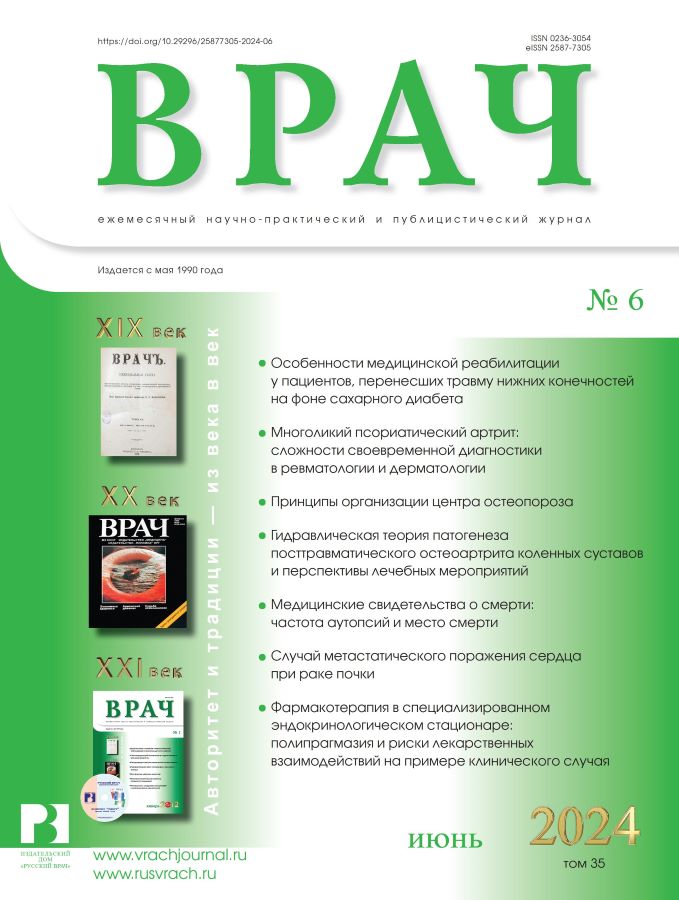Медицинские свидетельства о смерти: частота аутопсий и место смерти
- Авторы: Какорина Е.П.1,2, Самородская И.В.2, Чернявская Т.К.1
-
Учреждения:
- Московский областной научно-исследовательский клинический институт им. М.Ф. Владимирского
- Первый МГМУ им. И.М. Сеченова Минздрава России (Сеченовский Университет)
- Выпуск: Том 35, № 6 (2024)
- Страницы: 29-34
- Раздел: Здравоохранение
- URL: https://journals.eco-vector.com/0236-3054/article/view/633938
- DOI: https://doi.org/10.29296/25877305-2024-06-05
- ID: 633938
Цитировать
Полный текст
Аннотация
В мире отмечается значительная вариабельность частоты аутопсий и места смерти.
Цель. Провести сравнительный анализ места смерти и частоты аутопсий городского и сельского населения в зависимости от класса болезней в регионах Центрального федерального округа (ЦФО) Российской Федерации.
Материал и методы. Использовались таблицы Росстата «Распределение умерших по источнику сведений об умершем и месту смерти в 2022 году» для городского и сельского населения. Для анализа отобраны 11 из 22 классов болезней по МКБ-10, доля которых в смертности населения составляет >95%.
Результаты. Частота проведения аутопсий среди городского населения ЦФО от любой причины (70,64±14,79%) выше, чем среди сельского (61,69±15,49%; р=0,09). Наибольшая доля аутопсий наблюдалась в случаях смерти от внешних причин (ВП) (99,8±0,2%) и инфекционных болезней (ИБ) (в среднем городское население – 87,6±21,1%, сельское – 82,3±26,6%; максимум – 100%; минимум – 53,5%). Минимальная доля аутопсий зарегистрирована по 18-му классу (R) «Симптомы, признаки и отклонения от нормы, выявленные при клинических и лабораторных исследованиях, не классифицированные в других рубриках» (31,29±27,47; минимум – 4%, максимум – 95%) и по 6-му классу (G) «Болезни нервной системы» (БНС) (35,51±29,77; минимум – 32,25%; максимум – 97,5%). Среднерегиональная доля умерших в стационаре (от всех причин среди городского населения – 39,19±5,37%, среди сельского – 32,38±5,04%; р<0,0001) была самой высокой в случае смерти от ИБ (городское население – 79,14±10,8%, сельское – 76,32±11,25%) и минимальной – в трех классах: БНС, R и ВП. Среднерегиональная доля умерших дома (от всех причин среди городского населения – 45,04±6,64%, среди сельского – 52,38±6,04%; р=0,002). Наиболее высокая доля смертей на дому зарегистрирована по классу БНС (сельское население – 77,51±7,99%; максимум – 88% и минимум – 13%).
В случае смерти от ВП местом смерти было «место происшествия»: максимум – в Костромской области (58,8%, сельское население), минимум – в Липецкой области (14,3%, городское население) и Москве (16,2%).
Заключение. Выявлена значительная межрегиональная вариабельность частоты аутопсий и места смерти в зависимости от причины смерти и места жительства (город/село).
Ключевые слова
Полный текст
Об авторах
Е. П. Какорина
Московский областной научно-исследовательский клинический институт им. М.Ф. Владимирского; Первый МГМУ им. И.М. Сеченова Минздрава России (Сеченовский Университет)
Email: samor2000@yandex.ru
ORCID iD: 0000-0001-6033-5564
доктор медицинских наук, профессор, Институт лидерства и управления здравоохранением
Россия, Москва; МоскваИ. В. Самородская
Первый МГМУ им. И.М. Сеченова Минздрава России (Сеченовский Университет)
Автор, ответственный за переписку.
Email: samor2000@yandex.ru
ORCID iD: 0000-0001-9320-1503
доктор медицинских наук, профессор, Институт лидерства и управления здравоохранением
Россия, МоскваТ. К. Чернявская
Московский областной научно-исследовательский клинический институт им. М.Ф. Владимирского
Email: samor2000@yandex.ru
ORCID iD: 0000-0003-0227-8076
кандидат медицинских наук
Россия, МоскваСписок литературы
- Драпкина О.М., Самородская И.В., Черкасов С.Н. и др. Кодирование причин смерти: необходимость решения проблем (согласованная позиция). Профилактическая медицина. 2021; 24 (9): 66–73 [Drapkina O.M., Samorodskaya I.V., Cherkasov S.N. et al. Coding for causes of death: the need to address issues (consensus statement). The Russian Journal of Preventive Medicine. 2021; 24 (9): 66–73 (in Russ.)]. doi: 10.17116/profmed20212409166
- Adair T. Who dies where? Estimating the percentage of deaths that occur at home. BMJ Glob Health. 2021; 6 (9): e006766. doi: 10.1136/bmjgh-2021-006766
- Kjellstadli C., Husebø B.S., Sandvik H. et al. Comparing unplanned and potentially planned home deaths: a population-based cross-sectional study. BMC Palliat Care. 2018; 17: 69. doi: 10.1186/s12904-018-0323-3
- Abe K., Kawachi I., Taniguchi Y. et al. Municipal Characteristics of In-Home Death Among Care-Dependent Older Japanese Adults. JAMA Netw Open. 2022; 5 (1): e2142273. doi: 10.1001/jamanetworkopen.2021.42273
- Hoyert D.L. Autopsies in the United States in 2020. Natl Vital Stat Rep. 2023; 72 (5): 1–11. URL: https://www.cdc.gov/nchs/data/nvsr/nvsr72/nvsr72-05.pdf
- Latten B.G.H., Kubat B., van den Brandt P.A. et al. Cause of death and the autopsy rate in an elderly population. Virchows Arch. 2023; 483 (6): 865–72. doi: 10.1007/s00428-023-03571-0
- Sanchez H. Autopsy Rate and Physician Attitudes Toward Autopsy. Medscape (online). URL: https://emedicine.medscape.com/article/1705948-overview#a1
- Goldman L. Autopsy 2018: still necessary, even if occasionally not sufficient. Circulation. 2018; 137 (25): 2686–8. doi: 10.1161/CIRCULATIONAHA.118.033236
- Paratz E.D., Rowe S.J., Stub D. et al. A systematic review of global autopsy rates in all-cause mortality and young sudden death. Heart Rhythm. 2023; 20 (4): 607–13. doi: 10.1016/j.hrthm.2023.01.008
- Breslow J.M. More deaths go unchecked as autopsy rate falls to “miserably low” levels. Frontline [online]. URL: http://www.pbs.org/wgbh/frontline/article/more-deaths-go-unchecked-as-autopsy-rate-falls-to-miserably-low-levels/
- Wittschieber D., Klauschen F., Kimmritz A.C. et al. Who is at risk for diagnostic discrepancies? Comparison of pre- and postmortal diagnoses in 1800 patients of 3 medical decades in East and West Berlin. PLoS One. 2012; 7 (5): e37460. doi: 10.1371/journal.pone.0037460
- Cotogni P., Saini A., De Luca A. In-Hospital Palliative Care: Should We Need to Reconsider What Role Hospitals Should Have in Patients with End-Stage Disease or Advanced Cancer? J Clin Med. 2018; 7 (2): 18. doi: 10.3390/jcm7020018
- Bajwah S., Oluyase A.O., Yi D. et al. The effectiveness and cost-effectiveness of hospital-based specialist palliative care for adults with advanced illness and their caregivers. Cochrane Database Syst Rev. 2020; 9 (9): CD012780. doi: 10.1002/14651858.CD012780.pub2
- Sheikh M., Sekaran S., Kochhar H. et al. Hospice vs Palliative care: A comprehensive review for primary care physician. J Family Med Prim Care. 2022; 11 (8): 4168–73. doi: 10.4103/jfmpc.jfmpc_2262_21
Дополнительные файлы






